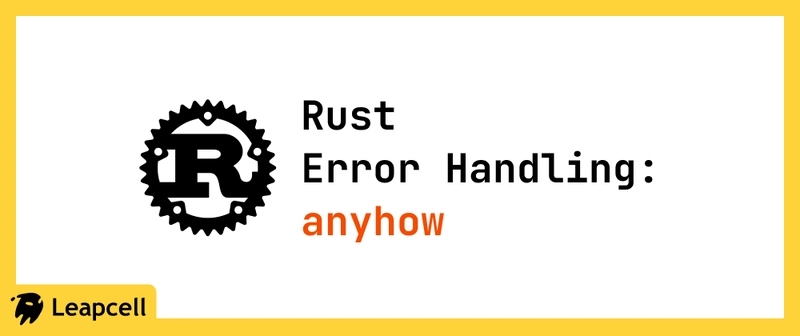Simplifying Rust Error Handling with anyhow
Preface anyhow is a popular crate in Rust for error handling. It provides a simple and flexible way to manage errors, making it especially suitable for rapid development and prototyping. anyhow primarily simplifies error handling by offering a general-purpose error type, anyhow::Error, allowing developers to reduce boilerplate without sacrificing error information. The following is a detailed introduction to anyhow, including its features, usage, and best practices. Why Use anyhow? In Rust, error handling typically uses the Result type, where E is an error type implementing the std::error::Error trait. Although this approach is highly flexible, it can lead to excessive boilerplate and repetitive error conversion logic in complex projects. anyhow simplifies this process by offering a general error type: Simplified error types: No need to define specific error types for every function. Automatic error conversion: Automatically converts different error types into anyhow::Error using the ? operator. Rich error information: Supports chained error messages, providing detailed error context. Basic Usage To use anyhow, you first need to add the dependency in Cargo.toml: [dependencies] anyhow = "1.0" Creating and Returning Errors An anyhow::Error can be created using the anyhow! macro: use anyhow::{anyhow, Result}; fn might_fail(succeed: bool) -> Result { if succeed { Ok(()) } else { Err(anyhow!("Operation failed")) } } In this example, the might_fail function returns a Result. If the operation fails, it returns an anyhow::Error containing an error message. Using the ? Operator A key feature of anyhow is its compatibility with the ? operator, which automatically converts various error types into anyhow::Error: use std::fs::File; use anyhow::Result; fn open_file(filename: &str) -> Result { let file = File::open(filename)?; Ok(file) } In this example, if File::open returns an error, the ? operator automatically converts it into an anyhow::Error and returns it. Adding Context Information Providing context when handling errors can greatly aid debugging. anyhow provides the Context trait to support this: use std::fs::File; use anyhow::{Context, Result}; fn open_file_with_context(filename: &str) -> Result { let file = File::open(filename) .with_context(|| format!("Failed to open file: {}", filename))?; Ok(file) } The with_context method allows you to add custom context to the error chain, which will be displayed when the error is printed or logged. Error Chains anyhow::Error supports error chaining, meaning one error can contain information about another. This is very helpful for debugging complex issues: use std::fs::File; use anyhow::{anyhow, Result}; fn read_file(filename: &str) -> Result { let mut file = File::open(filename) .map_err(|e| anyhow!("Failed to open file: {}", e))?; let mut contents = String::new(); file.read_to_string(&mut contents) .map_err(|e| anyhow!("Failed to read file: {}", e))?; Ok(contents) } In this example, map_err is used to convert standard library errors into anyhow::Error while adding additional context. Comparison with Other Error Handling Crates anyhow is similar to crates like thiserror and eyre, but their design goals differ: anyhow: Mainly for application-level error handling, offering a simple API and flexibility. thiserror: Used to define custom error types, better suited for library development where detailed error types are needed. eyre: Similar to anyhow, but offers more extensibility and customization features. Best Practices in Practice Rapid prototyping: During the early stages of development or in fast iterations, using anyhow can reduce the complexity of error handling. Application-level error handling: For most error handling needs in applications, anyhow provides sufficient functionality. Combine with logging: When used with logging libraries (such as log or tracing), you can record detailed information when errors occur. Convert errors at boundaries: At library boundaries, consider using thiserror to define specific error types, and use anyhow for conversion at the application layer. Conclusion anyhow is a powerful error handling crate in Rust, particularly well-suited for application-level error management. By providing a general-purpose error type and rich context information, it simplifies the complexity of error handling. Leveraging the features of anyhow can significantly improve development efficiency and code readability. We are Leapcell, your top choice for hosting Rust projects. Leapcell is the Next-Gen Serverless Platform for Web Hosting, Async Tasks, and Redis: Multi-Language Support Develop with Node.js, Python, Go, or Rust. Deploy unlimited projects for free pay only for

Preface
anyhow is a popular crate in Rust for error handling. It provides a simple and flexible way to manage errors, making it especially suitable for rapid development and prototyping. anyhow primarily simplifies error handling by offering a general-purpose error type, anyhow::Error, allowing developers to reduce boilerplate without sacrificing error information. The following is a detailed introduction to anyhow, including its features, usage, and best practices.
Why Use anyhow?
In Rust, error handling typically uses the Result type, where E is an error type implementing the std::error::Error trait. Although this approach is highly flexible, it can lead to excessive boilerplate and repetitive error conversion logic in complex projects. anyhow simplifies this process by offering a general error type:
- Simplified error types: No need to define specific error types for every function.
-
Automatic error conversion: Automatically converts different error types into
anyhow::Errorusing the?operator. - Rich error information: Supports chained error messages, providing detailed error context.
Basic Usage
To use anyhow, you first need to add the dependency in Cargo.toml:
[dependencies]
anyhow = "1.0"
Creating and Returning Errors
An anyhow::Error can be created using the anyhow! macro:
use anyhow::{anyhow, Result};
fn might_fail(succeed: bool) -> Result<()> {
if succeed {
Ok(())
} else {
Err(anyhow!("Operation failed"))
}
}
In this example, the might_fail function returns a Result. If the operation fails, it returns an anyhow::Error containing an error message.
Using the ? Operator
A key feature of anyhow is its compatibility with the ? operator, which automatically converts various error types into anyhow::Error:
use std::fs::File;
use anyhow::Result;
fn open_file(filename: &str) -> Result<File> {
let file = File::open(filename)?;
Ok(file)
}
In this example, if File::open returns an error, the ? operator automatically converts it into an anyhow::Error and returns it.
Adding Context Information
Providing context when handling errors can greatly aid debugging. anyhow provides the Context trait to support this:
use std::fs::File;
use anyhow::{Context, Result};
fn open_file_with_context(filename: &str) -> Result<File> {
let file = File::open(filename)
.with_context(|| format!("Failed to open file: {}", filename))?;
Ok(file)
}
The with_context method allows you to add custom context to the error chain, which will be displayed when the error is printed or logged.
Error Chains
anyhow::Error supports error chaining, meaning one error can contain information about another. This is very helpful for debugging complex issues:
use std::fs::File;
use anyhow::{anyhow, Result};
fn read_file(filename: &str) -> Result<String> {
let mut file = File::open(filename)
.map_err(|e| anyhow!("Failed to open file: {}", e))?;
let mut contents = String::new();
file.read_to_string(&mut contents)
.map_err(|e| anyhow!("Failed to read file: {}", e))?;
Ok(contents)
}
In this example, map_err is used to convert standard library errors into anyhow::Error while adding additional context.
Comparison with Other Error Handling Crates
anyhow is similar to crates like thiserror and eyre, but their design goals differ:
-
anyhow: Mainly for application-level error handling, offering a simple API and flexibility. -
thiserror: Used to define custom error types, better suited for library development where detailed error types are needed. -
eyre: Similar toanyhow, but offers more extensibility and customization features.
Best Practices in Practice
-
Rapid prototyping: During the early stages of development or in fast iterations, using
anyhowcan reduce the complexity of error handling. -
Application-level error handling: For most error handling needs in applications,
anyhowprovides sufficient functionality. -
Combine with logging: When used with logging libraries (such as
logortracing), you can record detailed information when errors occur. -
Convert errors at boundaries: At library boundaries, consider using
thiserrorto define specific error types, and useanyhowfor conversion at the application layer.
Conclusion
anyhow is a powerful error handling crate in Rust, particularly well-suited for application-level error management. By providing a general-purpose error type and rich context information, it simplifies the complexity of error handling. Leveraging the features of anyhow can significantly improve development efficiency and code readability.
We are Leapcell, your top choice for hosting Rust projects.
Leapcell is the Next-Gen Serverless Platform for Web Hosting, Async Tasks, and Redis:
Multi-Language Support
- Develop with Node.js, Python, Go, or Rust.
Deploy unlimited projects for free
- pay only for usage — no requests, no charges.
Unbeatable Cost Efficiency
- Pay-as-you-go with no idle charges.
- Example: $25 supports 6.94M requests at a 60ms average response time.
Streamlined Developer Experience
- Intuitive UI for effortless setup.
- Fully automated CI/CD pipelines and GitOps integration.
- Real-time metrics and logging for actionable insights.
Effortless Scalability and High Performance
- Auto-scaling to handle high concurrency with ease.
- Zero operational overhead — just focus on building.
Explore more in the Documentation!
Follow us on X: @LeapcellHQ










































































![[Career Advice] 6 years in frontend (React / React Native) - confused about future](https://media2.dev.to/dynamic/image/width%3D1000,height%3D500,fit%3Dcover,gravity%3Dauto,format%3Dauto/https:%2F%2Fdev-to-uploads.s3.amazonaws.com%2Fuploads%2Farticles%2Fmm890ouoldk9e918dh2w.png)

